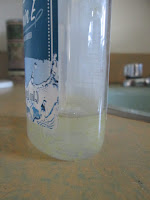One of the challenges of the ecofrugal life is that it can make simple things more complicated. For example, this past week I ran into a very simple problem that most people would solve by just running to the store and buying something. But because that wasn't an ecofrugal option, I ended up having to make something instead.
Until now, that is. With the rise of COVID, hand sanitizer has become a hot commodity, and stores just can't keep the stuff in stock. Ever since the outbreak started, I've been keeping a nervous eye on my one bottle of hand-sanitizer deodorant as the level crept lower and lower. Eventually it reached the point where I couldn't get any more out with the stupid pump top (which I hate anyway because it's not recyclable and it prevents me from turning the bottle upside down to drain it). I had to start removing the top and attempting to extract some with my fingers each morning, which was a pain.
I tried my local drugstore and supermarket, one other supermarket, and two other drugstores, and most of them had no hand sanitizer at all in stock. One store had some, but in 750-milliliter bottles (clearly from a distillery that's switched gears during the pandemic) for $10, which is about three times the normal price. Of course, all these stores had deodorant, which hasn't been in short supply, and I could have just bought some, but I hated the idea of letting the pandemic force me into less ecofrugal habits. So instead, I decided to try something I'd heard about from a friend: mixing up my own hand sanitizer. The main ingredients were rubbing alcohol and aloe vera gel, both of which I already had at home, so it wouldn't cost me anything to try.
A quick search turned up several recipes online from sources such as Healthline, Wired, Popular Science, and Everyday Health. Most of these called for a ratio of two parts isopropyl alcohol to one part aloe. They also stressed that it was important to use alcohol with a concentration of at least 90 percent in order to achieve a mixture with 60 percent alcohol, which is the level needed to kill the coronavirus. The stuff I had at home was only 70 percent alcohol, but since I was only relying on the stuff to deodorize rather than sanitize, I figured it didn't matter if it was a little weak. So I just measured two tablespoons of alcohol and one tablespoon of aloe vera gel into the nearly-empty container I was already using.
 Most of the recipes also called for essential oils, such as tea tree, lavender, or citrus. However, it wasn't clear whether these were supposed to enhance the antibacterial properties of the gel or just make it smell nicer. I didn't have any of these handy, but we did have a lemon in the fridge, and the peel of that is a perfectly good source of nice-smelling essential oil. So Brian helpfully took off just a little bit of the zest for me — maybe a quarter-teaspoon — and I added that to the mix as well and shook it up.
Most of the recipes also called for essential oils, such as tea tree, lavender, or citrus. However, it wasn't clear whether these were supposed to enhance the antibacterial properties of the gel or just make it smell nicer. I didn't have any of these handy, but we did have a lemon in the fridge, and the peel of that is a perfectly good source of nice-smelling essential oil. So Brian helpfully took off just a little bit of the zest for me — maybe a quarter-teaspoon — and I added that to the mix as well and shook it up.
So far, I've only used this DIY deodorant once, but it seems to work about as well as the commercial hand sanitizer did. And I've still got about half a bottle of rubbing alcohol left and most of a bottle of aloe vera gel, so I'm hoping this will be a sufficient supply to continue mixing up my homemade deodorizing gel as needed until the shortage resolves itself.
But if it isn't, I can always revert to one of the other DIY deodorants I tried during my series of experiments: milk of magnesia. This stuff worked reasonably well for me, and it's not one of the things there's been a run on during the pandemic. The only reason I stopped using it the first time around was that I discovered it to have an unwelcome laxative effect. However, since then, I've actually developed a magnesium deficiency and started taking supplements for it daily — so if I find the topically applied magnesium is having the same effect this time around, I can simply cut down on the amount I take orally to compensate. In fact, who knows — using the magnesium topically as a deodorant might just eliminate the need for the supplements entirely, killing two birds with one stone. That's what I'd call an ecofrugal solution.




No comments:
Post a Comment